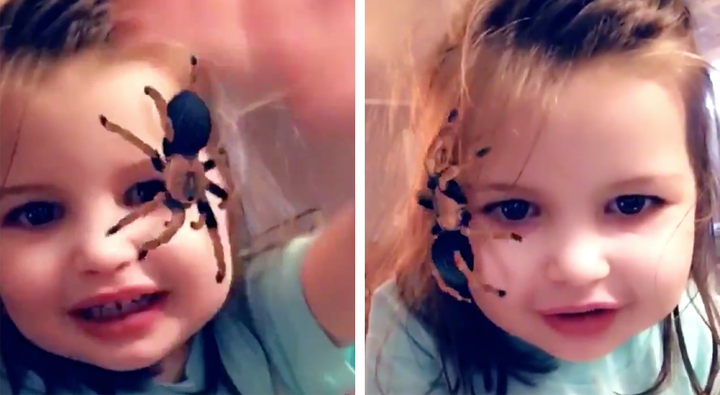
Halloween might be behind us, but that hasn’t stopped parents from continuing the scare fest with their kids. Many are taking great delight in using a new Snapchat filter where a superimposed spider crawls across their child’s face.
While some kids don’t seem bothered by the filter (totally chill, you guys), others have been filmed crying hysterically. In one clip, a toddler tries desperately to bat the tarantula away, but to no avail.
The video, which has more than 100,000 likes, has divided the internet. Some believe it’s harmless fun, while others say it’s traumatic for young children. One wrote: “I don’t see what’s funny. I have a little four-year-old and I can’t imagine doing something like this to her.”
It raises the question: is it ever okay to scare your child?
“It’s all about balance and knowing your kids,” says Dr Amanda Gummer, a psychologist specialising in child development and founder of Fundamentally Children. “I think by not doing it [scaring them] you’re depriving your kids of learning opportunities.”
It can also help children to be more empathetic, she says. By being on the receiving end of the joke, they will have empathy and won’t go too far with their own jokes in the future. So where do the boundaries lie with pranking your kids? Here’s what you need to know.
Assess whether they can handle it.
If you’re considering playing a scary prank on your child, assess whether they’ll be able to handle it emotionally.
You know your children, says Gummer. If they are generally happy, safe, secure, they know they’re loved and they feel okay in themselves, then it’s probably not going to do any lasting damage. But if they’re vulnerable, struggling or even just having a bad day, it could have negative repercussions.
In general, you do need to be able to play a prank on a child and help them learn it’s just a joke, she says. So it’s worth assessing how they react to scary jokes. “If the kid is inconsolable and has nightmares for weeks afterwards, you’ve probably got someone who’s a bit more sensitive and needs a bit more caution around those kinds of issues,” she says.
Figure out whether it’s age-appropriate.
As a rule of thumb, if a child is not old enough to understand the explanation of the prank, then they’re not old enough to be scared.
Speaking about the spider Snapchat filter, Gummer says with two-year-olds, it feels like it “might just be mean”, but with five-, six-, seven-year-olds, it can be more of a family joke.
“You could argue that 30 seconds of ‘oh my god, oh my god’ and then them realising it’s just a joke actually teaches them quite an important lesson,” adds Gummer. “And if that’s the way it happens, then great. But if they’re having nightmares for the next three weeks, [that’s] not so great.”

Think about the context.
How well the “scare” lands with your child also depends on the context, explains Gummer. “If it’s a joke that all the family are in on and all of the kids are a bit freaked out by it – but then they can all have a laugh about it afterwards – that’s fine,” she says.
“If it’s everyone ganging up on the youngest member of the family and making them feel terrified, then no [that’s not ok].”
Don’t make the prank too elaborate.
Another video that recently went viral on social media was of a mum who dressed up in a costume that looked like she was being abducted by an alien. In the video, her worried kids ran after her.
Situations like this can be tricky, says Dr Gummer, as a child’s imagination can run wild and they might then actually fear that aliens are going to come and take away their mum. Again, this depends on age and the individual child.
Instead, keep it simple. Jumping out from behind a tree or doing a trick, such as pretending your thumb has been chopped off, are ways you can scare children – then quite quickly let them in on the secret without traumatising them, she says.
This teaches children to learn not to take everything at face value and to do some critical thinking, she explains, but not to the extent that it becomes difficult to do that.
And finally, make sure you explain the joke.
When the joke’s over, explain to your kids what has happened and give them a hug to make sure they feel safe.
And next time, let them have a go. “Let them try the costume on afterwards, let them pretend to be an alien, let them put a spider on their mum’s face,” she says. “They might not still like it, but it won’t traumatise them.”